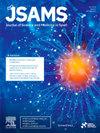The impact of injuries on sports-related analgesic use in Danish youth elite athletes: A 4-week prospective cohort study
IF 3
2区 医学
Q1 SPORT SCIENCES
引用次数: 0
Abstract
Objectives
Investigate the association between injury severity and sports-related analgesic use, and explore the types and reasons for analgesic use in Danish youth elite athletes.
Design
4-week prospective cohort study.
Methods
713 youth elite athletes (44 % female) aged 15–20 years provided information on demographics, sports specific questions, and injury severity. We categorized injury severity based on the amount of impact on sports participation: 1) no injury (reference), 2) injury not affecting sports participation, 3) injury causing modifications in sports participation, and 4) injury causing complete absence from sport. Participants were asked weekly over 4 weeks about the number of days with sports-related analgesic use, types, and reasons for use. Mixed-effects regression models were used to assess the association between injury severity and prevalence (yes/no) and frequency (days/week) of analgesic use.
Results
Analgesic use at least once during the four weeks was reported by 224 athletes (31 %), with a mean weekly prevalence of 13 %. The odds of analgesic use increased with injury severity compared with the reference group; injury not affecting sports participation: OR 2.6 (95 % CI 1.6–4.2), injury causing modifications in sports participation: OR 3.2 (95 % CI 2.0–5.2), injury causing complete absence from sport: OR 3.6 (95 % CI 1.5-8.7) (test for trend; p = < 0.001). The rate (frequency) of analgesic use also increased with injury severity (test for trend; p = 0.003). Athletes most commonly used analgesics to treat pain/injury after sports participation (62 %), and paracetamol was most frequently used (84 %).
Conclusions
Injury severity was associated with increased odds and rate of analgesic use.
丹麦青少年精英运动员受伤对运动相关镇痛药使用的影响:一项为期四周的前瞻性队列研究。
目标:调查受伤严重程度与运动相关镇痛药使用之间的关系,探索丹麦青少年精英运动员使用镇痛药的类型和原因:调查丹麦青少年精英运动员受伤严重程度与运动相关镇痛药使用之间的关系,并探讨使用镇痛药的类型和原因。设计:为期 4 周的前瞻性队列研究。方法:713 名 15-20 岁的青少年精英运动员(44% 为女性)提供了有关人口统计学、运动特定问题和受伤严重程度的信息。我们根据对运动参与的影响程度对受伤严重程度进行了分类:1)没有受伤(参考);2)受伤不影响运动参与;3)受伤导致运动参与有所改变;4)受伤导致完全退出运动。在 4 周内,每周都会询问参与者与运动相关的镇痛剂使用天数、类型和使用原因。混合效应回归模型用于评估受伤严重程度与使用镇痛剂的普遍程度(是/否)和频率(天/周)之间的关系:有 224 名运动员(31%)报告在四周内至少使用过一次镇痛剂,平均每周使用率为 13%。与参照组相比,使用镇痛药的几率随着受伤严重程度的增加而增加;受伤不影响运动参与:不影响运动的损伤:OR 2.6(95 % CI 1.6-4.2),影响运动的损伤:OR 3.2(95 % CI 1.6-4.2):OR 3.2 (95 % CI 2.0-5.2),受伤导致完全缺席运动:OR 3.6(95 % CI 1.5-8.7)(趋势检验;P = 结论:受伤严重程度与使用镇痛剂的几率和比例增加有关。
本文章由计算机程序翻译,如有差异,请以英文原文为准。
求助全文
约1分钟内获得全文
求助全文
来源期刊
CiteScore
7.40
自引率
10.00%
发文量
198
审稿时长
48 days
期刊介绍:
The Journal of Science and Medicine in Sport is the official journal of Sports Medicine Australia (SMA) and is an an international refereed research publication covering all aspects of sport science and medicine.
The Journal considers for publication Original research and Review papers in the sub-disciplines relating generally to the broad sports medicine and sports science fields: sports medicine, sports injury (including injury epidemiology and injury prevention), physiotherapy, podiatry, physical activity and health, sports science, biomechanics, exercise physiology, motor control and learning, sport and exercise psychology, sports nutrition, public health (as relevant to sport and exercise), and rehabilitation and injury management. Manuscripts with an interdisciplinary perspective with specific applications to sport and exercise and its interaction with health will also be considered.

 求助内容:
求助内容: 应助结果提醒方式:
应助结果提醒方式:


